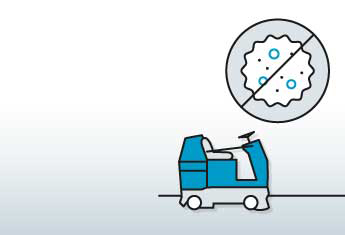Your shopping cart is empty.
Quick Tips for Cleaning & Disinfecting Floors
Posted in Health & Safety, Best Practices,

In the past, floors may have been considered a non-critical environmental surface, but the pandemic changed everyone’s perception of which surfaces are critical to keeping customers and employees safe. While regularly cleaning your facility’s floor is probably common practice, do you know the differences between cleaning and disinfecting?
Cleaning and Disinfecting: Know the Difference
Floor cleaning is the physical removal of soil, debris, and organic substances from a surface. Cleaning is an important step in the disinfection process. Auto-scrubbers can be used to perform this important task between disinfection processes while people are present, since cleaning solution is applied to the floor and quickly removed to prevent slip-fall accidents.
Floor disinfecting is the use of chemical solutions that eliminate pathogens and disease-causing microorganisms. These chemicals require a dwell time of up to 10 minutes (times vary) to do their job. This task is performed after cleaning and when an area can be closed off as the floor remains wet for at least the required dwell time.
Tips for Disinfecting Floors
- Before cleaning the floor, remove loose soil, debris and other substances.
- Use a floor scrubber to complete a thorough floor cleaning, which removes stubborn soils and organic materials that can be hospitable to microorganisms. Allow floors to completely dry before continuing.
- Select an EPA-approved disinfectant and ensure the chemical you choose is approved for use on your flooring type. The EPA maintains a list of registered disinfectants that meet the EPA’s criteria.
- Always wear appropriate Personal Protective Equipment (PPE) when preparing and using a disinfectant solution.
- Prepare the disinfectant solution according to label directions. Carefully follow directions for use, including contact times, to ensure effectiveness.
- Always restrict foot traffic while treating areas and use appropriate safety protocols, such as placing barricades and using prominent safety signs, to avoid slip and fall accidents while floors remain wet.
- Apply the disinfectant with spray applicators, mops or auto-scrubbers operating in a mode that allows solution to remain on the floor for the necessary dwell time. If using a Tennant auto-scrubber:
- Set the auto-scrubber to double-scrub by raising or removing the squeegee.
- Set solution flow on lowest possible solution flow rate.
- Scrub at a rate to distribute disinfectant across scrub path.
- Ensure the disinfectant remains in contact with the floor surface for the required time, allowing surfaces to air dry following application.
- Drain tanks of remaining disinfectant solution immediately after use. Rinse floor machine with water using conventional scrubbing to remove any product residue inside to reduce the potential for chemical interaction issues.
- Additional cleaning processes can be used between disinfection cycles to create a clean and safe environment for customers, guests and employees.
- Even when used as directed, using disinfectant in an auto-scrubber may cause premature wear and additional service calls as disinfectants can be more damaging than detergents.
- Using a disinfectant without adequate contact time on the surface creates a false sense of safety and wasted funds. Traditional use of auto-scrubbers put solution down and recovers it in 2-3 seconds. This is not long enough to achieve efficacy.
Tips for Cleaning & Disinfecting Auto-Scrubbers*
- Before selecting a cleaner or disinfectant, review labels to determine if the chemistry is compatible with your floor scrubber’s surfaces and parts. Some disinfectants, just like some cleaning products, can corrode metals, plastics and types of rubber.
- Thoroughly clean all hard, non-porous surfaces of the machine. After cleaning, allow time for surfaces to completely air dry prior to disinfection.
- Thoroughly apply the disinfectant by wiping or spraying and carefully follow contact time and PPE instructions.
- If some surfaces cannot be reached via wipe or spray, it may be necessary to dissemble and immerse the parts in disinfectant.
- Wipe and rinse equipment with water to remove disinfectant residues from machine, paying specific attention to the scrub deck, squeegees and other areas prone to chemical corrosion in order to reduce the potential for damage to your equipment. Take care not to spray electrical components of the machine.
*Always read and follow the instructions for your brand of floor scrubber.
Contact us for information on how Tennant can address your cleaning needs.
RELATED LINKS
Ready to take your cleaning to the next level?
Whether you are requesting a product demonstration or a quote, ordering parts, or making a service appointment, you've come to the right place. Tennant professional representatives are ready with answers to your questions, and we look forward to showing you how much we appreciate your business.


